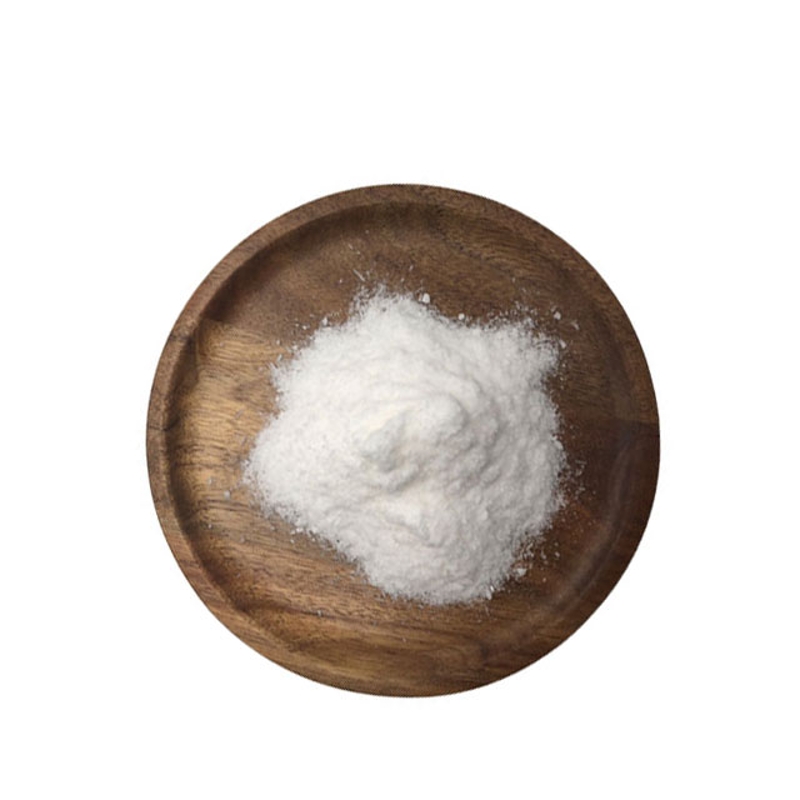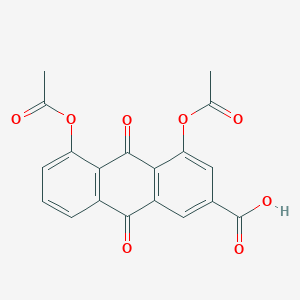-
Categories
-
Pharmaceutical Intermediates
-
Active Pharmaceutical Ingredients
-
Food Additives
- Industrial Coatings
- Agrochemicals
- Dyes and Pigments
- Surfactant
- Flavors and Fragrances
- Chemical Reagents
- Catalyst and Auxiliary
- Natural Products
- Inorganic Chemistry
-
Organic Chemistry
-
Biochemical Engineering
- Analytical Chemistry
- Cosmetic Ingredient
-
Pharmaceutical Intermediates
Promotion
ECHEMI Mall
Wholesale
Weekly Price
Exhibition
News
-
Trade Service
iNature Interleukin 33 Receptor (IL-33R) mediates local inflammatory responses and plays a key role in the pathogenesis of immune diseases such as pulmonary fibrosis and rheumatoid arthritis
.
Whether and how IL-33R is regulated remains a mystery
.
On March 1, 2022, a research paper titled "Reciprocal regulation of IL-33 receptor–mediated inflammatory response and pulmonary fibrosis by TRAF6 and USP38" was published online by Wuhan University Li Shu and Shu Hongbing and other teams.
Ubiquitin-specific protease 38 (USP38) was identified as a negative regulator of IL-33R-mediated signaling
.
USP38 deficiency promotes interleukin 33 (IL-33)-induced downstream proinflammatory responses in vitro and in vivo
.
Usp38−/− mice were more susceptible to inflammatory injury and death, and developed more severe pulmonary fibrosis after bleomycin treatment
.
USP38 is constitutively associated with IL-33R and uncouples its K27-linked polyubiquitination at K511, leading to its autophagic degradation
.
This study further shows that the E3 ubiquitin ligase tumor necrosis factor receptor-associated factor 6 (TRAF6) catalyzes the K27-associated polyubiquitination of IL-33R at K511, and that TRAF6 deficiency inhibits IL-33-mediated signaling
.
Taken together, our findings demonstrate that K27-related polyubiquitination and deubiquitination of IL-33R by TRAF6 and USP38 reciprocally regulate IL-33R levels and signaling, which represents the modulation of IL-33-triggered pneumonia responses and lung Key Mechanisms of Fibrosis
.
Interleukin 33 (IL-33), a member of the interleukin 1 (IL-1) family, plays a critical role in innate and adaptive immunity, contributes to tissue homeostasis and responds to the environment Excited reaction
.
IL-33 is constitutively expressed in a variety of cells, including human epithelial cells and lung endothelial cells, as a steady-state chromatin-associated nuclear cytokine
.
IL-33 is released as an alarm following cellular damage to alert the immune system to tissue damage during trauma or infection
.
Overactivation of IL-33 has been shown to lead to severe local inflammation as well as autoimmune or immune-related diseases, such as severe lung damage
.
Overexpression of IL-33 has been observed in patients with chronic fibrosis, including idiopathic pulmonary fibrosis
.
IL-33 promotes interleukin 33 receptor (IL-33R)-dependent pulmonary fibrosis by inducing alternate activation of mouse macrophages and innate lymphocytes
.
Anti-IL-33 antibody treatment reduces airway inflammation in a mouse model of allergic asthma
.
IL-33R, also known as inhibitory tumorigenicity 2 (ST2), is the canonical type I transmembrane receptor for IL-33
.
Binding of IL-33 to IL-33R triggers a series of signaling events that lead to a local immune response
.
The first step in IL-33 signaling is a ligand-induced conformational change in IL-33R, which contributes to the recruitment of interleukin-1 receptor accessory protein (IL-1RAP)
.
Activated heterodimeric complexes recruit downstream signaling components, including myeloid differentiation primary response protein 88 (MyD88), IL-1 receptor (IL-1R)-related kinase, tumor necrosis factor (TNF) receptor-related factor 6 (TRAF6) ) and the transforming growth factor (TGF)-beta-activated kinase 1 (TAK1) complex, leading to TAK1 activation
.
TAK1 subsequently activates nuclear factor kappa-B kinase subunit alpha (IKKα) and downstream kinase inhibitors of IKKβ
.
These events ultimately lead to activation of the transcription factor NF-κB and induction of downstream effector genes
.
USP38 inhibits IL-33-triggered signaling (figure from PNAS) While overactivation of IL-33-triggered signaling is associated with a variety of diseases, the IL-33/IL-33R axis is tightly regulated under physiological conditions
.
sST2, a soluble and secreted form of IL-33R/ST2, inhibits IL-33-triggered signaling by competing with IL-33R for binding to IL-33
.
IL-33-triggered signaling is inhibited by the single immunoglobulin domain interleukin 1 receptor-related molecule (SIGIRR; also known as TIR8), which disrupts the dimerization of IL-33R and IL-1RAP
.
Previous studies have shown that post-translational modifications play a critical role in the regulation of the IL-1R family
.
For example, the E3 ubiquitin ligases MARCH3 and MARCH8 mediate K48-linked polyubiquitination and degradation of IL-1R and IL-1RAP, respectively, resulting in the negative regulation of IL-1-triggered inflammatory responses
.
It was previously reported that the E3 ubiquitin ligase FBXL19 mediates the polyubiquitination of IL-33R, and overexpression of FBXL19 attenuated IL-33-triggered inflammatory responses
.
Deubiquitinating enzymes remove ubiquitin conjugates from their target proteins, thereby regulating their stability, localization, or activity
.
Ubiquitin-specific protease 38 (USP38) was originally identified as a negative regulator of type I interferon signaling by regulating TANK-binding kinase 1 ubiquitination
.
Furthermore, USP38 has been shown to be downregulated in colorectal cancer and act as a tumor suppressor by deubiquitinating HDAC3, thereby controlling the expression of cancer stem cell-related genes
.
In this study, USP38 was identified as a negative regulator of IL-33-triggered signaling
.
USP38 deficiency enhances IL-33-induced pneumonitis response and bleomycin-induced pulmonary fibrosis
.
Mechanistically, this study demonstrates that K27-linked polyubiquitination of IL-33RK511 is critical for its stability
.
USP38 is constitutively associated with IL-33R, leading to partial uncoupling of K27-linked polyubiquitin in IL-33RK511 and its autophagic degradation
.
This study also identified TRAF6 as an E3 ubiquitin ligase that catalyzes the K27-linked polyubiquitination of IL-33RK511
.
These findings suggest that K27-linked polyubiquitination and deubiquitination of IL-33R by TRAF6 and USP38, respectively, are key regulatory mechanisms for fine-tuning IL-33R-mediated inflammatory responses
.
Reference message: https://
.
Whether and how IL-33R is regulated remains a mystery
.
On March 1, 2022, a research paper titled "Reciprocal regulation of IL-33 receptor–mediated inflammatory response and pulmonary fibrosis by TRAF6 and USP38" was published online by Wuhan University Li Shu and Shu Hongbing and other teams.
Ubiquitin-specific protease 38 (USP38) was identified as a negative regulator of IL-33R-mediated signaling
.
USP38 deficiency promotes interleukin 33 (IL-33)-induced downstream proinflammatory responses in vitro and in vivo
.
Usp38−/− mice were more susceptible to inflammatory injury and death, and developed more severe pulmonary fibrosis after bleomycin treatment
.
USP38 is constitutively associated with IL-33R and uncouples its K27-linked polyubiquitination at K511, leading to its autophagic degradation
.
This study further shows that the E3 ubiquitin ligase tumor necrosis factor receptor-associated factor 6 (TRAF6) catalyzes the K27-associated polyubiquitination of IL-33R at K511, and that TRAF6 deficiency inhibits IL-33-mediated signaling
.
Taken together, our findings demonstrate that K27-related polyubiquitination and deubiquitination of IL-33R by TRAF6 and USP38 reciprocally regulate IL-33R levels and signaling, which represents the modulation of IL-33-triggered pneumonia responses and lung Key Mechanisms of Fibrosis
.
Interleukin 33 (IL-33), a member of the interleukin 1 (IL-1) family, plays a critical role in innate and adaptive immunity, contributes to tissue homeostasis and responds to the environment Excited reaction
.
IL-33 is constitutively expressed in a variety of cells, including human epithelial cells and lung endothelial cells, as a steady-state chromatin-associated nuclear cytokine
.
IL-33 is released as an alarm following cellular damage to alert the immune system to tissue damage during trauma or infection
.
Overactivation of IL-33 has been shown to lead to severe local inflammation as well as autoimmune or immune-related diseases, such as severe lung damage
.
Overexpression of IL-33 has been observed in patients with chronic fibrosis, including idiopathic pulmonary fibrosis
.
IL-33 promotes interleukin 33 receptor (IL-33R)-dependent pulmonary fibrosis by inducing alternate activation of mouse macrophages and innate lymphocytes
.
Anti-IL-33 antibody treatment reduces airway inflammation in a mouse model of allergic asthma
.
IL-33R, also known as inhibitory tumorigenicity 2 (ST2), is the canonical type I transmembrane receptor for IL-33
.
Binding of IL-33 to IL-33R triggers a series of signaling events that lead to a local immune response
.
The first step in IL-33 signaling is a ligand-induced conformational change in IL-33R, which contributes to the recruitment of interleukin-1 receptor accessory protein (IL-1RAP)
.
Activated heterodimeric complexes recruit downstream signaling components, including myeloid differentiation primary response protein 88 (MyD88), IL-1 receptor (IL-1R)-related kinase, tumor necrosis factor (TNF) receptor-related factor 6 (TRAF6) ) and the transforming growth factor (TGF)-beta-activated kinase 1 (TAK1) complex, leading to TAK1 activation
.
TAK1 subsequently activates nuclear factor kappa-B kinase subunit alpha (IKKα) and downstream kinase inhibitors of IKKβ
.
These events ultimately lead to activation of the transcription factor NF-κB and induction of downstream effector genes
.
USP38 inhibits IL-33-triggered signaling (figure from PNAS) While overactivation of IL-33-triggered signaling is associated with a variety of diseases, the IL-33/IL-33R axis is tightly regulated under physiological conditions
.
sST2, a soluble and secreted form of IL-33R/ST2, inhibits IL-33-triggered signaling by competing with IL-33R for binding to IL-33
.
IL-33-triggered signaling is inhibited by the single immunoglobulin domain interleukin 1 receptor-related molecule (SIGIRR; also known as TIR8), which disrupts the dimerization of IL-33R and IL-1RAP
.
Previous studies have shown that post-translational modifications play a critical role in the regulation of the IL-1R family
.
For example, the E3 ubiquitin ligases MARCH3 and MARCH8 mediate K48-linked polyubiquitination and degradation of IL-1R and IL-1RAP, respectively, resulting in the negative regulation of IL-1-triggered inflammatory responses
.
It was previously reported that the E3 ubiquitin ligase FBXL19 mediates the polyubiquitination of IL-33R, and overexpression of FBXL19 attenuated IL-33-triggered inflammatory responses
.
Deubiquitinating enzymes remove ubiquitin conjugates from their target proteins, thereby regulating their stability, localization, or activity
.
Ubiquitin-specific protease 38 (USP38) was originally identified as a negative regulator of type I interferon signaling by regulating TANK-binding kinase 1 ubiquitination
.
Furthermore, USP38 has been shown to be downregulated in colorectal cancer and act as a tumor suppressor by deubiquitinating HDAC3, thereby controlling the expression of cancer stem cell-related genes
.
In this study, USP38 was identified as a negative regulator of IL-33-triggered signaling
.
USP38 deficiency enhances IL-33-induced pneumonitis response and bleomycin-induced pulmonary fibrosis
.
Mechanistically, this study demonstrates that K27-linked polyubiquitination of IL-33RK511 is critical for its stability
.
USP38 is constitutively associated with IL-33R, leading to partial uncoupling of K27-linked polyubiquitin in IL-33RK511 and its autophagic degradation
.
This study also identified TRAF6 as an E3 ubiquitin ligase that catalyzes the K27-linked polyubiquitination of IL-33RK511
.
These findings suggest that K27-linked polyubiquitination and deubiquitination of IL-33R by TRAF6 and USP38, respectively, are key regulatory mechanisms for fine-tuning IL-33R-mediated inflammatory responses
.
Reference message: https://







